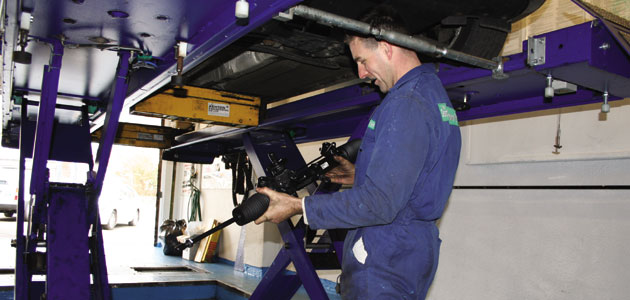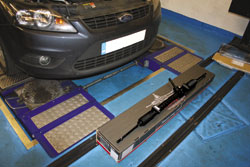
Michael Flensborg, Sales & Marketing Director at Remy Automotive UK, explains why it’s important to get a steering replacement right at the first attempt.

As the VMs are constantly making their engines more compact for environmental and fuel economy reasons, it can be a time-consuming job to replace a steering rack or pump. This is why it’s essential the technician gets it right first time. The labour costs alone in replacing a unit which is not fitted properly can be prohibitive. Remy has one of the largest steering rack and steering pump ranges available to the UK market. As a result we are in a unique position to give some valuable diagnostics advice on what to do before changing a leaking steering rack – a safety critical component.
Before removing the old steering rack from the vehicle, it’s important to centralise the steering wheel and ensure that both wheels are in line. Once the rack has been removed a very good tip is to wind the new rack to its stop, then wind fully to the other stop – counting the rotations – and then wind back half the rotations. This will centralise the pinion. Lay both racks next to one another and, because the steering was centralised on the vehicle before removing the OE rack, both pinion positions on both racks should be identical. When the replacement rack is fitted this ensures the steering wheel will be in the central position with the minimum amount of tracking being required.
Another important tip during tracking is that Remy provides small adjustable clips attached to the rubber gaiter and tie rod. It’s essential that during the tracking process these clips are undone to prevent the rubber gaiters from being twisted during tracking. This will ensure the gaiters are not damaged/split which can result in water debris ingress and cause premature failure. Additionally, if the rubber gaiters are twisted, it can cause a problem by restricting the movement of the rack.
Care should be taken when handling the supplied replacement rack. The aluminium bodies are easily damaged, and if damaged around the cylinder area may prevent the rack from moving freely when fitted. Damage can also be caused by the splines on the steering pinion if not correctly aligned with the steering coupling on fitment.
Small working space
As engine compartments offer such a small working space for the replacement of parts, steering racks can be particularly time-consuming to fit. Removal of the oil transfer pipes can help facilitate fitment of the rack at the mounting lugs. However, care must be taken when the oil feed pipes are refitted. Aluminium threads are easily damaged if over-tightened and will inevitably lead to the rack leaking from the transfer pipe nut.
Top tip checklist:
- Recognise the vital importance of diagnosing steering faults
- Always fully check the condition of the fixed and flexible hoses
- Make sure that the system is fully flushed
- Make sure that you get all the air out of the system
- Use VM’s recommended fluids
- Take care in installation of a rack
When to check the steering? At Remy we always recommend that the steering be checked at the time of the annual service and MOT. Probably the most common reason for the steering rack to be replaced, therefore, is as a result of MOT failure. However, the contamination contained in the hydraulic system is often left in the system when the replacement is installed. As a result, this contamination can dramatically reduce the life of the replacement rack by scoring the inside of the rack, creating both internal and external leaks.
At Remy we always recommend that the steering be checked at the time of the annual service and MOT. Probably the most common reason for the steering rack to be replaced, therefore, is as a result of MOT failure. However, the contamination contained in the hydraulic system is often left in the system when the replacement is installed. As a result, this contamination can dramatically reduce the life of the replacement rack by scoring the inside of the rack, creating both internal and external leaks.
That’s why it’s essential to follow the most important first step when replacing the rack or, for that matter, the pump or any other hydraulic steering component. Before unbolting anything make sure that you flush the whole system with new, clean manufacturer’s recommended fluid.
This can be done quickly and easily by disconnecting the pressure line from the rack and positioning it in a waste oil receptacle. You then fill the pump fluid reservoir to the full level with fresh fluid, start the engine and continue pouring and flushing until clean fluid exits from the pressure line. This ‘tip’ can save a lot of extra work later, reducing the chance of the vehicle being returned under warranty. It also improves customer satisfaction and increases the life expectancy of the replacement steering rack.
With such a safety critical component, these are more than just some ‘tips’ on steering replacement, they are an essential aspect of professional motor repair!









